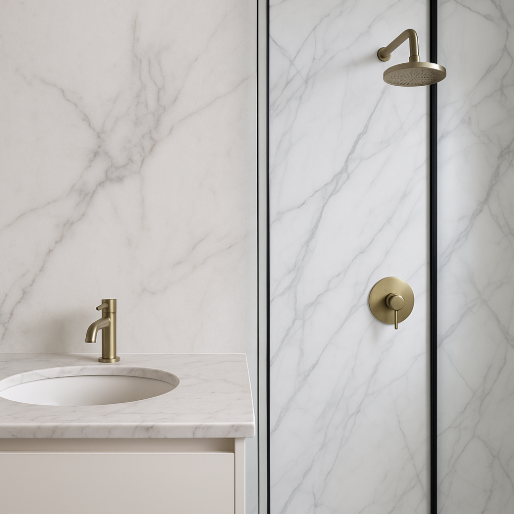Table of Contents
The first time I priced real marble, I left the showroom with two things: a camera roll full of dreamy slab photos and a mini heart attack. I loved the way the stone felt under my fingers cool, silky, almost like it had its own quiet pulse but I couldn’t ignore the voice in my head saying, “Are you ready to babysit this every day?” A week later, a contractor friend showed me PVC marble sheets. We propped a panel against my bathroom wall, and I remember thinking, “Okay… this gives me the look I want without the panic.” If you’re standing in that same crossroads romance on one side, reality on the other here’s the human, no-nonsense comparison I wish someone had given me before I spent hours spiraling on Pinterest.
How They Actually Look
Real marble has a soul. The veining is never perfectly symmetrical, and the stone glows in a way that’s hard to fake. When morning sun hits a honed marble vanity, the surface feels alive soft, matte, quietly luxurious. It’s easy to fall in love with that. PVC marble sheets, meanwhile, are about consistency and calm. The print technology has come a long way; the veining has depth, not the flat “photo” look older panels had. When I installed a light Calacatta pattern in a small bath, the room suddenly felt bigger because the panels run in long, uninterrupted stretches. And there’s a certain peace in knowing every sheet matches without playing slab Tetris. Do PVC panels pass a nose-on-the-wall test? If you’re hunting for the microscopic sparkle of calcite, no. From a normal distance in a finished room with good lighting? Absolutely convincing and very, very pretty.
The Price Conversation We All Tiptoe Around
Let’s say it out loud: real marble is expensive. You pay for quarrying, shipping, thickness, edge profiles, sink cutouts, and pros who know how to wrestle a fragile, heavy slab into place. The final bill can feel like buying the same room twice. PVC marble sheets live in a different universe. You buy large panels that cover a lot of area fast, you add adhesive and a few trims, and you’re off to the races. Even if you hire an installer, the labor time is shorter and the risk lower. When I did the math for my bathroom walls and shower surround, the PVC route came in at a fraction of the stone quote and I didn’t have to sell a kidney or start a GoFundMe for grout maintenance.
What It’s Like to Install
Installing real marble is part sculpture, part moving day. Slabs are heavy, edges chip if you breathe wrong, and any mistake is an expensive mistake. You’ll want a fabricator and a crew, plus waterproofing behind the stone if it’s going in a shower. It’s beautiful work, but it’s not a DIY victory lap. PVC marble sheets feel more like building fine cabinetry. We scored and cut with normal tools, dry-fit everything like a puzzle, ran continuous beads of panel adhesive, and pressed the sheets into place. Fewer seams mean fewer places to fuss over. The only moment I held my breath was sealing the inside corners steady hand, one clean pass, walk away. If you can measure carefully and resist the urge for “one more swipe,” you’re golden.
Durability Where Daily Life Actually Happens
Here’s the truth no brochure loves to print. Real marble is strong but tender. It will carry scratch marks like tiny memories. Acidic things lemon, vinegar, some skincare products can etch the surface and dull the finish in a second. You can reseal, rehoned, and repair, but you’ll learn to live with patina. Some people adore that European café vibe; they see a story in every mark. Others see a fresh stain and want to cry into their baking soda paste. PVC marble sheets shrug off most of the drama that happens on walls: toothpaste clouds, shampoo drips, steam, random hair dye adventures. They’re non-porous, so splashes don’t sink in, and there’s no grout to babysit. Are they heat-warriors? Not really don’t put them behind a roaring stove or pressed against a radiator. But as vertical cladding in bathrooms, laundry rooms, and commercial spaces, they are the definition of unfussy.
Water, Steam, and That Sneaky Mold You Never See Coming
Bathrooms are humid little wrestling matches. Water sneaks into corners and sits there plotting. With PVC marble sheets, the face is waterproof, the panels are big (so you have fewer seams), and once you seal corners and edges neatly, there aren’t many places for moisture to party. I noticed something subtle after switching: the shower squeegee basically became ornamental. A quick wipe with a cloth and the walls looked like I’d just installed them. Marble, by comparison, relies on what’s behind it membranes, careful detailing, and ongoing sealing to keep water out of the wall. The stone itself can temporarily darken at edges or spot if water lingers. Manageable? Yes. Forgiving? Not especially.
Cleaning and Maintenance (Your Future Saturdays Will Thank You)
Living with marble is a relationship. You’ll use pH-neutral cleaners, you’ll blot instead of rub, you’ll reseal periodically, and you’ll make peace with calling a pro if an etch really bugs you. Some folks find that ritual grounding. I tried to be one of those folks. I lasted three months. Living with PVC panels is… boring, in the best way. Warm water, mild soap, microfiber cloth. Done. No sealing calendar, no panic when someone sprays the wrong cleaner, no late-night Google searches for “how to get turmeric stain out of marble without making it worse.”
Repairs When Life Happens
Drop a tool and chip a marble edge? You can fill and polish and get it “good from a foot,” but you won’t be swapping half a slab. Drop the same tool against a PVC panel? You’ve usually nicked sealant or grazed the surface. Worst case, you replace a panel not ideal, but doable without rewriting the whole room. On the flip side, marble has this superpower: if the wear is broad rather than localized, you can rehone or repolish the whole surface and it comes back like a glow-up. That’s real magic.
Heat, Sun, and Temperature Swings
Marble doesn’t flinch around heat. Curling iron slip-ups, warm mugs on a vanity, afternoon sun stone stays stone. PVC panels prefer normal indoor temps, so don’t put them where they’ll bake. In a bathroom with a decent fan and sensible radiator placement, you’re perfectly fine. In a kitchen right behind a gas hob? Choose tile or stone there, and save PVC for the adjacent walls.
Health, Air, and Planet Stuff (Said Simply)
Stone is natural and can last generations. The trade-off is the energy to quarry, ship, and fabricate it. PVC panels are manufactured but lightweight to transport, easy to cut with minimal waste, and, when paired with low-VOC adhesives, kind to indoor air. My rule is practical: put each material where it will last longest with the least drama. That alone is a greener choice than installing something beautiful in the wrong place and replacing it two years later.
Resale and What Buyers Actually Notice
In certain markets, the words “real marble” make buyers’ pupils dilate. Counters and floors in natural stone still have cachet. But here’s the quiet truth of listing photos and walk-throughs: a clean, bright bathroom with crisp, modern wall panels shows beautifully, and most buyers are reacting to the vibe, not the mineralogy. In rentals and flips, PVC panels often win on ROI because they install fast, look expensive, and don’t create future maintenance headaches for you or your tenants.
Where Each Material Makes You Happiest
If a space needs to behave perfectly with minimal effort primary shower, kids’ bath, laundry wall, hotel bathroom PVC marble sheets are your reliable friend. If a space is meant to be savored an elegant powder room vanity, a fireplace hearth, a kitchen island where you’ll cook and chat and daydream real marble writes a love story you’ll reread for years. The smartest homes I’ve seen use both: PVC where water and mess live, marble where hands linger and light can show off.
Five Years Later: What You’ll Be Glad You Chose
When I imagine five years ahead, here’s what I see. The PVC-clad shower still looks crisp because cleaning it never felt like a chore. The seams are tidy because I let the sealant cure and I actually use the fan (future you: do this). The marble in the powder room has a couple of soft marks only I notice, and I kind of love them the patina looks like time, not damage. If you know you’re maintenance-allergic, PVC will make you happier day to day. If you like materials that record life a little, marble will make you smile every time you wash your hands.
The Honest Verdict (From Someone Who Wanted It All)
If budget and simplicity are leading the conversation, PVC marble sheets are a gift. They deliver the airy, marble-inspired look, they stand up to humidity, and they don’t ask for weekend custody of your time. If romance and tactility are your North Star and you’re willing to care for a living material real marble will absolutely delight you. I landed in the middle: PVC for the walls that see water and chaos, marble for the moments I want to feel special. That mix feels like grown-up practicality with room for joy.
If you want help making the call for your space, tell me the room size, what surfaces you’re covering, and whether you prefer subtle or bold veining. I’ll sketch a layout, estimate panels or slab sq. ft., and recommend trims, sealants, or edges that won’t fight you. Whichever way you go, aim for this: a room that looks beautiful on day one and still feels easy on day one thousand.



